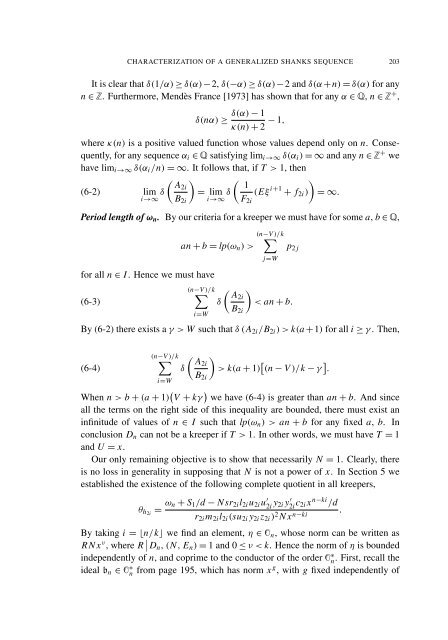Characterization of a generalized Shanks sequence - Department of ...
Characterization of a generalized Shanks sequence - Department of ...
Characterization of a generalized Shanks sequence - Department of ...
You also want an ePaper? Increase the reach of your titles
YUMPU automatically turns print PDFs into web optimized ePapers that Google loves.
CHARACTERIZATION OF A GENERALIZED SHANKS SEQUENCE 203<br />
It is clear that δ(1/α) ≥ δ(α)−2, δ(−α) ≥ δ(α)−2 and δ(α +n) = δ(α) for any<br />
n ∈ . Furthermore, Mendès France [1973] has shown that for any α ∈ , n ∈ + ,<br />
δ(nα) ≥<br />
δ(α) − 1<br />
− 1,<br />
κ(n) + 2<br />
where κ(n) is a positive valued function whose values depend only on n. Consequently,<br />
for any <strong>sequence</strong> αi ∈ satisfying limi→∞ δ(αi) = ∞ and any n ∈ + we<br />
have limi→∞ δ(αi/n) = ∞. It follows that, if T > 1, then<br />
(6-2) lim<br />
i→∞ δ<br />
<br />
A2i<br />
= lim<br />
i→∞ δ<br />
<br />
1<br />
<br />
= ∞.<br />
B2i<br />
(Eξ<br />
F2i<br />
i+1 + f2i)<br />
Period length <strong>of</strong> ωn. By our criteria for a kreeper we must have for some a, b ∈ ,<br />
for all n ∈ I . Hence we must have<br />
(6-3)<br />
(n−V )/k<br />
an + b = lp(ωn) ><br />
(n−V )/k<br />
i=W<br />
δ<br />
A2i<br />
B2i<br />
j=W<br />
p2 j<br />
<br />
< an + b.<br />
By (6-2) there exists a γ > W such that δ (A2i/B2i) > k(a +1) for all i ≥ γ . Then,<br />
(6-4)<br />
(n−V )/k<br />
i=W<br />
δ<br />
A2i<br />
B2i<br />
<br />
> k(a + 1) (n − V )/k − γ .<br />
When n > b + (a + 1) V + kγ we have (6-4) is greater than an + b. And since<br />
all the terms on the right side <strong>of</strong> this inequality are bounded, there must exist an<br />
infinitude <strong>of</strong> values <strong>of</strong> n ∈ I such that lp(ωn) > an + b for any fixed a, b. In<br />
conclusion Dn can not be a kreeper if T > 1. In other words, we must have T = 1<br />
and U = x.<br />
Our only remaining objective is to show that necessarily N = 1. Clearly, there<br />
is no loss in generality in supposing that N is not a power <strong>of</strong> x. In Section 5 we<br />
established the existence <strong>of</strong> the following complete quotient in all kreepers,<br />
θh2i = ωn + S1/d − Nsr2il2iu2iu ′ 2i y2i y ′ 2ic2i xn−ki /d<br />
r2im2il2i(su2i y2i z2i) 2N xn−ki .<br />
By taking i = ⌊n/k⌋ we find an element, η ∈ n, whose norm can be written as<br />
RN xν , where R Dn, (N, En) = 1 and 0 ≤ ν < k. Hence the norm <strong>of</strong> η is bounded<br />
independently <strong>of</strong> n, and coprime to the conductor <strong>of</strong> the order ∗ n . First, recall the<br />
ideal bn ∈ ∗ n from page 195, which has norm x g , with g fixed independently <strong>of</strong>

















